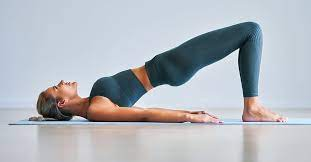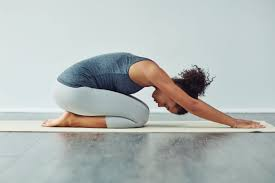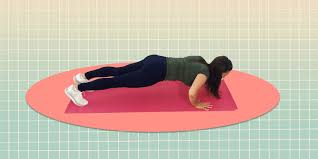9+ Best Exercise for Vertigo and to lose belly fat
Lower back exercises may help reduce and prevent lower back discomfort. Strengthens the core, leg, and arm muscles. These are the top ten exercises for relieving lower back pain.
Exercise, according to researchers' reputable sources, may decrease stiffness and speed up the healing process by increasing blood flow to the lower back region.
Here are 10 exercises that may help alleviate lower back discomfort and strengthen the lower back:
- Bridges
- Half-curls
- Supermans
- Stretching the cat
- Tilting of the pelvis is seen.
- A series of knees-to-chest exercises
- Rotational stretches for the lower back
- Maneuvers used to draw people in
- Leg raises to the side when lying down
- stretching the lower back when seated
1.) Bridges are an example of a structural element.
The gluteus maximus, a huge buttocks muscle, is worked by crossing across bridges. During squats, people use this muscle to move their hips and activate this muscle.
In order to keep the lower back stable, it is essential to have a strong gluteus maximus muscle. This is how you do it:
- Bend the knees and place the feet flat on the floor, hip-width apart, on the ground.
- Keep your arms at your sides and press your feet firmly against the floor.
- Strive to maintain a straight line from your shoulders to knees by elevating your buttocks.
- Keeping your shoulders on the floor, squeeze your buttocks.
- Lie down on your back and relax for a few seconds.
- After each set of 15 repetitions, take a one-minute break.
- Three sets of 15 repetitions each are recommended for this exercise.
2). Knee-to-chest stretches.
A knee-to-chest stretch may help relieve lower back strain and stiffness by elongating the lower back. For the knee-to-chest stretch, follow these steps: 9+ best exercises for Vertigo
- Lie on your back on the floor with your head supported by a pillow.
- When bending the knees, maintain both feet on the ground.
- Pull one knee toward the chest with both hands.
- Keeping the abdomen taut and forcing the spine into the floor, hold the knee against one's chest for five seconds.
- Get back to where you were before.
- Then switch legs and do it again.
- 2–3 times a day, alternate legs.
3.) Rotational stretches of the lower back are also beneficial.
To ease lower back and trunk stress, try the rotating stretch. It also helps to strengthen the core muscles, which helps with balance and stability. Stretch your lower back by rotating your lower body clockwise.
- Bend your knees and place your feet firmly on the ground while lying on your back.
- Gently move both bent legs to one side while keeping the shoulders firmly on the floor.
- Hold this posture for 5–10 seconds.
- Reset the clock to the beginning of the current period.
- After a few seconds of holding, gently move the bent knees over to the opposing side, and then return to the beginning position.
- Twice daily, do this exercise 2–3 times on each side.
4.) Techniques for attracting attention to oneself
The transversus abdominis is targeted by the draw-in technique.
Front and side abdominal muscles help stabilize the spine and lower back.
In order to execute the draw-in maneuver, follow these steps:
- Keep your arms at your sides as you recline back on the floor with your knees bent and your feet flat.
- Take a few deep breaths.
- As you exhale, tighten your abdominal muscles and maintain your hips motionless by pulling your belly button against your spine.
- For 5 seconds, keep the position you're in.
- Five times is a good rule of thumb.
5.) Tilting of the uterus
The pelvic tilt exercise may help loosen and maintain flexibility in stiff back muscles. To practice flexibility in the lower back, follow these steps:
- Keep your arms at your sides as you recline back on the floor with your knees bent and your feet flat.
- Inhale and exhale as you gently arch one's the lower back.
- Relax after holding for 5 seconds.
- Pull the belly button in toward the floor while flattening the back.
- Relax after holding for 5 seconds.
- Every day, work your way up to 30 repetitions.
6.) Leg raises while lying on the side
Exercises such as lying lateral leg lifts target the abductor muscles of the hip joint. These muscles serve to stabilize the pelvis, which in turn helps to alleviate back pain.
Maintaining the strength of these muscles is critical since they aid in a person's ability to maintain balance and mobility. To do lateral leg raises while laying down:
- Rest your legs together on one side of your body.
- Maintain a small bend in the lower leg.
- Engage the core muscles by drawing the belly button into the spine.
- Maintain a straight and stretched upper leg as you raise the leg around 18 inches.
- For the duration of two seconds, hold the position.
- Ten times is a good rule of thumb.
- Lift the opposite leg as you switch to the other side of your body.
- Set aside three minutes for each side.
7.) Stretched-out cat
Using the cat stretch may extend the back, strengthen the muscles, and reduce muscular tension in the back.
To do the cat stretch, follow these instructions:
- Position your knees hip-width apart on your hands and knees.
- Back arches with the belly button tucked in close to the spine.
- Allow your stomach to sink toward the floor as you slowly relax your muscles.
- Reset the clock to the beginning of the current period.
- Do this 3–5 times a day, ideally twice a day.
8.) Supermans
Maintaining excellent posture requires powerful back extensors. Both sides of the spine are covered by this group of muscles.
If you have weak back extensors, completing an exercise known as a "Superman" will assist. Superman: How to do it:
- Keep your legs spread out and flat on the ground while lying face down on the ground and extending your arms out in front of you.
- The hands and feet should be raised approximately six inches above the ground.
- To activate the core muscles, elevate the belly button off the floor and bring it in toward the spine.
- To prevent a neck injury, keep your head in a straight line and keep your eyes on the ground.
Extend the fingers and toes as far as they will go. - For the duration of two seconds, hold the position.
- Reset the clock to the beginning of the current period.
- Ten times is a good rule of thumb.
9.) Lower back stretches while seated in a comfortable position.
To alleviate discomfort, strengthen the lower back, and activate the core muscles, try the sitting lower back rotational stretch. Do this rotating stretch sitting with your lower back in an arched position:
- Sit with your feet flat on the floor on a stool or chair without arms.
- Keep your hips square and your spine tall as you do a right core twist.
- To help with the stretch, put your hands behind your head or on your right knee with your left.
Ten seconds later, release the position. - Repeat the drill on the left.
- Do this 3–5 times on each side, twice daily, for 3–5 days.
Curls that are just partially completed. Maintaining appropriate hip alignment is made easier by maintaining a healthy core via regular exercise and developing strong abdominal muscles.
Some best other posts are: Alzheimer Early Onset | Alcohol Calories | Sleep Disorder Treatment
10.) Partial curls are performed as follows.
Having weak abdominals might cause lower back discomfort because of a lack of core strength and stability. In order to establish a strong core, you should do curls and half curls.
- Lie on your back with your knees bent and your feet flat on the floor with your hips apart.
- You may do this with your hands crossed over your chest.
- Take a few deep breaths.
- Engage the abdominal muscles by squeezing the stomach on the exhale.
- Raise your chin and shoulders 2 inches off the floor while maintaining your neck in line with your spine.
- To return to the beginning position, hold for 5 seconds before releasing the hold.
- You should do the workout 10 times.
- Perform a total of three sets.
It is the finest conclusion for lower back discomfort.
Preventing injury, improving stability, and increasing flexibility are all possible outcomes of doing core-strengthening exercises.
For those who suffer from lower back discomfort, it is important to pay attention to their overall posture and the way they handle heavy things.
Doctors should be called if lower back discomfort is severe or doesn't go away with simple stretches and exercises.
If you find that any of these back exercises are making your discomfort worse, stop performing them right once and see a doctor. Best medicine for ED Treatment
If you want to get a quick ride on your back pain then Here are The Best medicine for unbearable pain: Soma 500mg, Prosoma 500mg & Pain O Soma 500mg are the best medicine for Muscle and Acute Pain, It gives the pain relaxation by relaxing the sensation.
Just click upon that product then place an order in very simple steps and get delivered to your door with safe packaging.









Comments
Post a Comment